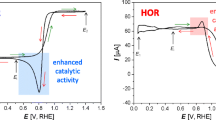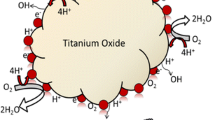Abstract
We demonstrate that alternating the oxygen partial pressure gradient across a yttria-stabilized zirconia (YSZ) electrolyte membrane prior to solid oxide fuel cell (SOFC) testing with nanoporous Pt electrodes greatly increases (e.g. by >70-fold at 350 °C) peak power density compared with devices without pretreatment. Transiently altering the oxygen activity at the cathode–YSZ interface appears to change the wetting characteristics of the nanoporous Pt, significantly affecting the stability and low-temperature performance of the SOFCs. Image analysis and impedance spectroscopy results suggest that an increase in triple-phase boundary area fraction at the cathode–YSZ interface contributes to the observed effect.







Similar content being viewed by others
References
Y.B. Kim, C.-M. Hsu, S.T. Connor, T.M. Gür, Y. Cui, and F.B. Prinz:Nanopore patterned Pt array electrodes for triple phase boundary study in low temperature SOFC. J. Electrochem. Soc. 157, B1269–B1274 (2010).
U.P. Muecke, D. Beckel, A. Bernard, A. Bieberle-Hütter, S. Graf, A. Infortuna, P. Müller, J.L.M. Rupp, J. Schneider, and L.J. Gauckler: Micro solid oxide fuel cells on glass ceramic substrates. Adv. Funct. Mater. 18, 3158–3168 (2008).
K. Kerman, B.K. Lai, and S. Ramanathan: Pt/Y0.16O1.92/Pt thin film solid oxide fuel cells: electrode microstructure and stability considerations. J. Power Sources 196, 2608–2614 (2011).
N. Baumann, E. Mutoro, and J. Janek: Porous model type electrodes by induced dewetting of thin Pt films on YSZ substrates. Solid State Ionics 181, 7–15 (2010).
H. Galinski, T. Ryll, P. Elser, J.L.M. Rupp, A. Bieberle-Hütter, and L.J. Gauckler: Agglomeration of Pt thin films on dielectric substrates. Phys. Rev. B 82, 235415 (2010).
T. Ryll, H. Galinski, L. Schlagenhauf, P. Elser, J.L.M. Rupp, A. Bieberle-Hutter, and L.J. Gauckler: Microscopic and nanoscopic three-phase-boundaries of platinum thin-film electrodes on YSZ electrolyte. Adv. Funct. Mater. 21, 565 (2011).
S.B. Adler: Factors governing oxygen reduction in solid oxide fuel cell cathodes. Chem. Rev. 104, 4791–4843 (2004).
T. Ryll, H. Galinski, L. Schlagenhauf, F. Rechberger, S. Ying, L.J. Gauckler, F.C.F. Mornaghini, Y. Ries, R. Spolenak, and M. Döbeli: Dealloying of platinum–aluminum thin films: electrode performance. Phys. Rev. B 84, 184111 (2011).
A. Toghan, M. Khodari, F. Steinbach, and R. Imbihl: Microstructure of thin film platinum electrodes on yttrium stabilized zirconia prepared by sputter deposition. Thin Solid Films 519, 8139 (2011).
E. Barsoukov and J.R. Macdonald: Impedance Spectroscopy, 2nd ed. (John Wiley & Sons, Inc, Hoboken, New Jersey, 2005) p. 521.
R. O’Hayre, S.W. Cha, W. Colella, and F.B. Prinz: Fuel Cell Fundamentals, 1st ed. (John Wiley & Sons, Inc, Hoboken, New Jersey, 2006) p. 234.
A.K. Opitz, M.P. Hörlein, T. Huber, and J. Fleig: Current–voltage characteristics of platinum model electrodes on yttria-stabilized zirconia. J. Electrochem. Soc. 159, B502 (2012).
M. Ni, M.K.H. Leung, and D.Y.C. Leung: Parametric study of solid oxide fuel cell performance. Energy Conv. Management 48, 1525 (2007).
H. Pöpkea, E. Mutorob, B. Luerßena, and J. Janek: Oxygen reduction and oxidation at epitaxial model-type Pt(O2)/YSZ electrodes–on the role of PtOx formation on activation, passivation, and charge transfer. Catal. Today 202, 12 (2013).
D.J. Srolovitz and S.A. Safran: Capillary instabilities in thin films. I. Energetics. J. Appl. Phys. 60, 247–254 (1986).
A.Y. Lin and P.C. McIntyre: Morphological stability of mesoporous Pt thin films deposited via nanosphere lithography on YSZ. Electrochem. Solid-State Lett. 14, B96–B100 (2011).
B.S. Clausen, J. Schiøtz, L. Grhbæk, C.V. Ovesen, K.W. Jacobsen, J.K. Norskov, and H. Topsøe: Wetting/non-wetting phenomena during catalysis: evidence from in situ on-line EXAFS studies of cu-based catalysts. Topics Catal. 1, 367–376 (1994).
Acknowledgments
We thank Prof. F.B. Prinz and his group at Stanford University for access to their Pt sputtering system. This research was supported in part by the Stanford Global Climate and Energy Project.
Author information
Authors and Affiliations
Corresponding author
Supporting Information
Supplementary materials
Supplementary materials
For supplementary material for this article, please visit {rs|http://dx.doi.org/10.1557/mrc.2013.25|url|}
Rights and permissions
About this article
Cite this article
Ginestra, C.N., McIntyre, P.C. Enhanced performance and endurance of nano-porous platinum solid oxide fuel cell electrodes by oxygen partial pressure cycling. MRS Communications 3, 123–128 (2013). https://doi.org/10.1557/mrc.2013.25
Received:
Accepted:
Published:
Issue Date:
DOI: https://doi.org/10.1557/mrc.2013.25




